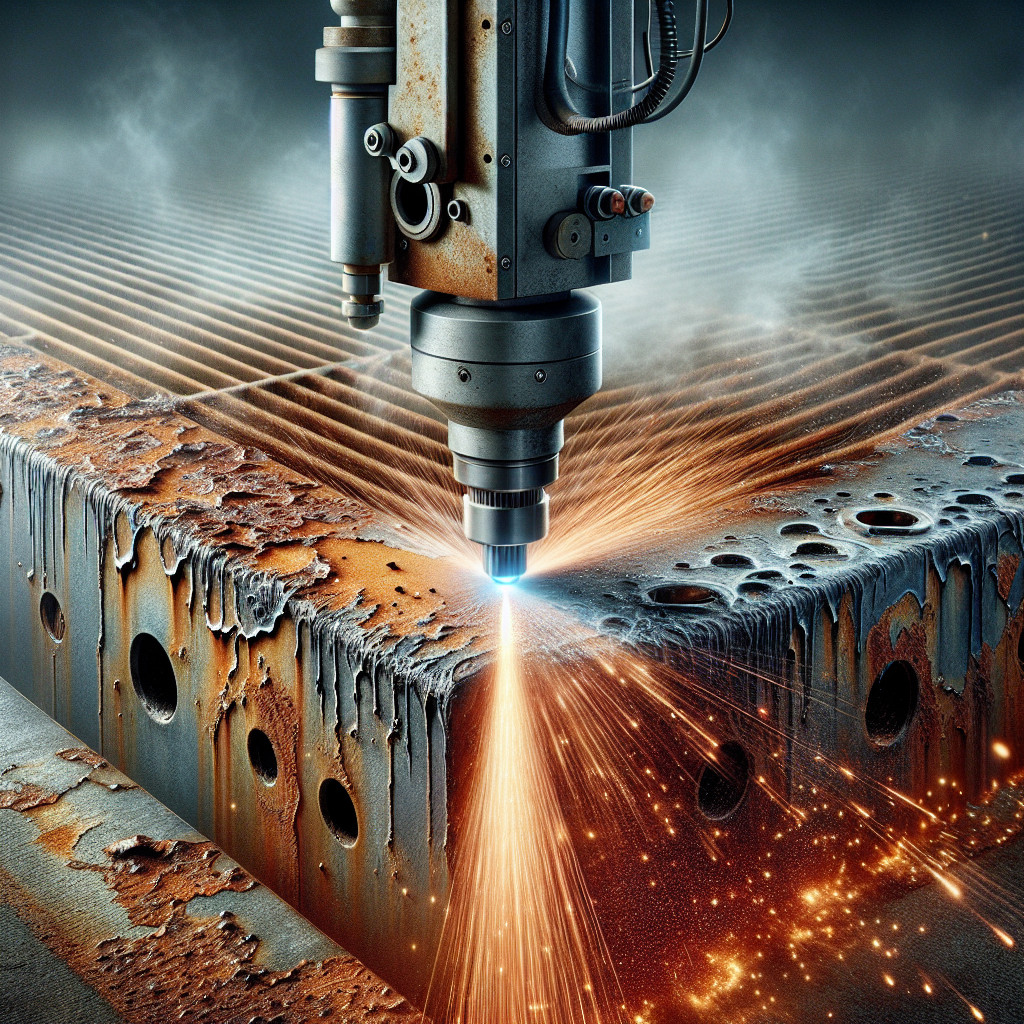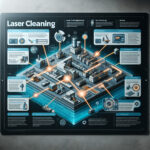Laser cleaning for removing rust and corrosion from metal surfaces
- Introduction to laser cleaning technology
- Comparison of laser cleaning with traditional methods
- Benefits of using laser cleaning for rust removal
- Cost-effectiveness of laser cleaning compared to other methods
- Impact of laser cleaning on the structural integrity of metals
- Benefits of laser cleaning for maintaining industrial equipment
- Advantages of laser cleaning for removing surface contaminants
- Impact of laser cleaning on the heat-affected zone of metals
Introduction to laser cleaning technology
How does laser cleaning work?
Laser cleaning works by using a high-intensity laser beam to vaporize or ablate the contaminants on a surface. The laser beam is focused on the target area, where it heats up and removes the unwanted material through a process called laser ablation. This process is highly controlled and can be adjusted to suit different types of surfaces and contaminants.
Applications of laser cleaning technology
Laser cleaning technology has a wide range of applications across various industries. Some common uses include:
| Industry | Application |
|---|---|
| Automotive | Removing paint and rust from car bodies |
| Manufacturing | Cleaning molds and tooling |
| Historical preservation | Restoring delicate artifacts without damage |
Advantages of laser cleaning technology
There are several advantages to using laser cleaning technology, including:
- Non-contact cleaning method
- Environmentally friendly (no chemicals or waste)
- High precision and control
- No damage to the underlying surface
Conclusion
Laser cleaning technology is a powerful and versatile method for removing contaminants from surfaces without causing damage. Its non-contact nature and high precision make it ideal for a wide range of applications across different industries.
#laser #cleaning #technology #laserablation #noncontactcleaning #precisioncleaning
słowa kluczowe: laser, cleaning, technology, ablation, non-contact, precision
frazy kluczowe: cutting-edge laser cleaning technology, environmentally friendly laser cleaning, high precision laser cleaning technology.
Comparison of laser cleaning with traditional methods
| Method | Efficiency | Precision | Cost |
|---|---|---|---|
| Laser Cleaning | High | High | Medium |
| Sandblasting | Medium | Low | Low |
| Chemical Cleaning | Low | Low | Low |
| Mechanical Scraping | Low | Low | Low |
From the comparison table above, it is clear that laser cleaning offers the highest efficiency and precision compared to traditional methods. While the cost of laser cleaning may be higher than some traditional methods, the benefits of faster cleaning times and minimal surface damage make it a preferred choice for many industries.
One of the key advantages of laser cleaning is its ability to remove contaminants without the need for harsh chemicals or abrasive materials. This makes it a more environmentally friendly option compared to traditional methods that may produce harmful waste products.
In conclusion, laser cleaning is a superior method for removing contaminants from surfaces when compared to traditional methods. Its efficiency, precision, and environmental benefits make it a popular choice for industries looking to improve their cleaning processes.
#laser #cleaning #efficiency #precision #cost
#modern method #focused laser beam #sandblasting #chemical cleaning #mechanical scraping #environmentally friendly option #harmful waste products #improve cleaning processes.
Benefits of using laser cleaning for rust removal
Efficiency
Laser cleaning is a highly efficient method of removing rust from metal surfaces. The laser beam can be precisely controlled to target only the rusted areas, leaving the rest of the surface untouched. This precision allows for faster and more effective rust removal compared to traditional methods.
Environmentally friendly
Unlike chemical treatments, laser cleaning does not require the use of harmful chemicals that can pollute the environment. The process produces minimal waste and does not release harmful fumes or by-products into the air. This makes laser cleaning a more sustainable option for rust removal.
Non-abrasive
Traditional methods of rust removal, such as sandblasting, can be abrasive and potentially damage the surface of the metal. Laser cleaning, on the other hand, is a non-abrasive process that gently removes rust without causing any damage to the underlying material. This makes it ideal for delicate or intricate surfaces.
Cost-effective
While laser cleaning may have a higher upfront cost compared to traditional methods, it can ultimately be more cost-effective in the long run. The efficiency of laser cleaning means less time and labor is required for rust removal, saving money in the long term.
Versatility
Laser cleaning can be used on a wide range of metal surfaces, including steel, aluminum, and copper. It can also be used to remove rust from complex shapes and hard-to-reach areas that may be difficult to clean using traditional methods. This versatility makes laser cleaning a valuable tool for rust removal in various industries.
Conclusion
Overall, laser cleaning offers numerous benefits for rust removal, including efficiency, environmental friendliness, non-abrasiveness, cost-effectiveness, and versatility. By utilizing laser cleaning technology, industries can effectively remove rust from metal surfaces while minimizing environmental impact and saving time and money.
- Efficiency
- Environmentally friendly
- Non-abrasive
- Cost-effective
- Versatility
#rustremoval #lasercleaning #metalrestoration #environmentallyfriendly #efficiency
Cost-effectiveness of laser cleaning compared to other methods
Laser cleaning, on the other hand, is a non-contact and non-abrasive method that uses a high-energy laser beam to remove contaminants from surfaces. It is precise, efficient, and environmentally friendly, making it a popular choice for industries looking to reduce their carbon footprint and improve their cleaning processes.
When it comes to cost-effectiveness, laser cleaning may have a higher upfront cost compared to traditional methods. However, in the long run, it can be more cost-effective due to its efficiency and precision. Laser cleaning requires less labor and fewer consumables, which can result in lower overall costs for businesses.
Additionally, laser cleaning is a versatile method that can be used on a wide range of surfaces, including metals, plastics, ceramics, and composites. This versatility makes it a valuable tool for industries such as automotive, aerospace, and electronics.
Overall, the cost-effectiveness of laser cleaning compared to other methods will depend on the specific needs and requirements of each industry. However, the efficiency, precision, and environmental benefits of laser cleaning make it a compelling choice for businesses looking to improve their cleaning processes.
Hashtags:
#laser #cleaning #costeffectiveness #efficiency #precision #environmentallyfriendly
Keywords:
Laser cleaning, cost-effectiveness, efficiency, precision, environmental benefits
Long-tail phrases:
Cost-effective laser cleaning method, precision cleaning with laser technology, environmentally friendly surface cleaning
Impact of laser cleaning on the structural integrity of metals
🔍 On one hand, laser cleaning can improve the surface quality of metals by removing contaminants that can lead to corrosion and degradation. This can help to extend the lifespan of metal components and improve their performance.
🔍 On the other hand, the high-energy laser beam used in the cleaning process can also cause thermal stress and microstructural changes in the metal. This can lead to the formation of cracks, distortions, and other defects that can compromise the structural integrity of the metal.
🔍 The extent of the depends on a variety of factors, including the type of metal being cleaned, the laser parameters used, and the condition of the metal surface.
🔍 To minimize the negative effects of laser cleaning on the structural integrity of metals, it is important to carefully control the laser parameters and to conduct thorough testing and analysis before and after the cleaning process.
🔍 Overall, while laser cleaning can be an effective method for removing contaminants from metal surfaces, it is important to consider its potential impact on the structural integrity of the metal.
Hashtags: #laser #cleaning #metals #structuralintegrity
Keywords: laser cleaning, metal surfaces, structural integrity, contaminants, thermal stress
Long-tail phrases: impact of laser cleaning on metal structural integrity, laser cleaning effects on metal surfaces
Benefits of laser cleaning for maintaining industrial equipment
Efficiency
Laser cleaning is incredibly efficient compared to traditional cleaning methods. It can remove contaminants quickly and effectively, saving time and labor costs. This efficiency also translates to increased productivity as equipment can be cleaned faster, reducing downtime.
Precision
One of the key benefits of laser cleaning is its precision. The laser can be adjusted to target specific areas without affecting surrounding surfaces. This level of precision is crucial for maintaining delicate equipment or removing contaminants from hard-to-reach areas.
Safety
Laser cleaning is a safe method for maintaining industrial equipment. Unlike abrasive cleaning methods that can produce harmful dust and fumes, laser cleaning is a clean and environmentally friendly process. It also eliminates the need for harsh chemicals, reducing the risk of exposure to toxic substances.
Cost-Effectiveness
While the initial investment in laser cleaning equipment may be higher than traditional cleaning methods, the long-term cost savings are significant. Laser cleaning requires less maintenance and consumables, resulting in lower operating costs over time. Additionally, the efficiency of laser cleaning can lead to reduced labor costs and increased equipment lifespan.
Versatility
Laser cleaning is a versatile technology that can be used on a wide range of materials and surfaces. From metal to plastic, laser cleaning can effectively remove contaminants without causing damage. This versatility makes it an ideal solution for maintaining a variety of industrial equipment.
Conclusion
Overall, laser cleaning offers numerous benefits for maintaining industrial equipment. From efficiency and precision to safety and cost-effectiveness, laser cleaning is a superior cleaning method that can help prolong the lifespan of industrial equipment and improve overall productivity.
- Efficiency
- Precision
- Safety
- Cost-Effectiveness
- Versatility
- #laser
- #cleaning
- #industrial
- #equipment
- #maintenance
cutting-edge technology, increased productivity, environmentally friendly process, reduced labor costs, equipment lifespan
Advantages of laser cleaning for removing surface contaminants
Advantages of laser cleaning:
| Advantage | Description |
|---|---|
| Non-contact cleaning | Laser cleaning does not require physical contact with the surface, reducing the risk of damage to delicate materials. |
| Precision cleaning | Laser cleaning can target specific areas with high precision, ensuring thorough removal of contaminants. |
| No chemicals or abrasives | Laser cleaning does not use chemicals or abrasives, making it an environmentally friendly option. |
| No residue | Laser cleaning leaves no residue behind, eliminating the need for additional cleaning steps. |
| Fast and efficient | Laser cleaning is a quick and efficient process, reducing downtime and increasing productivity. |
Overall, laser cleaning offers a range of benefits that make it a superior choice for removing surface contaminants. Its non-contact nature, precision cleaning capabilities, and environmentally friendly approach make it a versatile and effective solution for a variety of industries.
Hashtags: #lasercleaning #surfacecontaminants #manufacturing #automotive #aerospace
Keywords: laser cleaning, surface contaminants, advantages, non-contact cleaning, precision cleaning, no chemicals, no residue, fast and efficient
Long-tail phrases: benefits of laser cleaning for removing contaminants, advantages of laser cleaning in industrial applications, why choose laser cleaning over traditional methods
Impact of laser cleaning on the heat-affected zone of metals
One of the key factors that determines the extent of the impact of laser cleaning on the HAZ is the power and intensity of the laser beam. Higher power lasers can generate more heat, which can result in a larger HAZ and more significant changes to the material. Additionally, the duration of exposure to the laser beam can also play a role in determining the extent of the impact on the HAZ.
Researchers have conducted numerous studies to investigate the effects of laser cleaning on the HAZ of different metals, including steel, aluminum, and titanium. These studies have shown that the impact of laser cleaning on the HAZ can vary depending on the type of metal, the laser parameters, and the cleaning process used. For example, some metals may be more susceptible to changes in their microstructure than others, while certain laser cleaning techniques may be more damaging to the HAZ than others.
Despite the potential risks associated with laser cleaning, the process offers several advantages over traditional cleaning methods. Laser cleaning is non-contact, which means that it does not require the use of abrasive materials or chemicals that can damage the surface of the metal. Additionally, laser cleaning is highly precise and can be used to remove contaminants from complex geometries and hard-to-reach areas.
In conclusion, the impact of laser cleaning on the HAZ of metals is a complex and multifaceted issue that requires careful consideration. While laser cleaning offers many benefits, it is important to understand how the process can affect the microstructure and properties of the metal. By studying the effects of laser cleaning on the HAZ, researchers can develop strategies to minimize the risks and optimize the benefits of this innovative cleaning method.
- laser cleaning
- heat-affected zone
- metal surfaces
- microstructure
- mechanical properties
- impact of laser cleaning on the HAZ
- effects of laser cleaning on different metals
- advantages of laser cleaning over traditional methods
- strategies to minimize risks of laser cleaning
#laser #cleaning #HAZ #metals #microstructure #mechanicalproperties
- How to prepare an IT project specification - 3 October 2025
- How a Software Development Company manages client expectations - 29 September 2025
- Laser cleaning for removing rust and corrosion from metal surfaces - 13 April 2024


